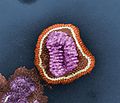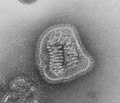Ta'ãnga:Influenza virus particle color.jpg

Tamaño de esta previsualización: 701 × 600 píxeles. Otras resoluciones: 281 × 240 píxeles | 561 × 480 píxeles | 898 × 768 píxeles | 1197 × 1024 píxeles | 1663 × 1423 píxeles.
Marandurenda moambue'ỹre (1663 × 1423 píxeles; tamaño de archivo: 205 kB; tipo MIME: image/jpeg)
Marandurenda rembiasakue
Ejopy peteĩ ára/aravo rehe rehecha hag̃ua pe marandurenda ojehechaukaháicha upe jave.
| Ára/Aravo | Michĩháicha | Tuichakue | Puruhára | Jehaimombyky | |
|---|---|---|---|---|---|
| ko’ag̃agua | 23:55 17 jasypo 2008 |  | 1663 × 1423 (205 kB) | Optigan13 | False color version, see PHIL#10073, 8430 |
Marandurenda jeporu
La siguiente página usa este archivo:
Marandurenda jepuru opaite tembiapópe
Ko'ã ambue wiki oipuru ko marandurenda:
- Jeporu ast.wikipedia.org rehe
- Jeporu cs.wikipedia.org rehe
- Jeporu de.wikipedia.org rehe
- Jeporu en.wikipedia.org rehe
- Jeporu es.wikipedia.org rehe
- Jeporu et.wikipedia.org rehe
- Jeporu fi.wikipedia.org rehe
- Jeporu fr.wikipedia.org rehe
- Jeporu gl.wikipedia.org rehe
- Jeporu id.wikipedia.org rehe
- Jeporu it.wikipedia.org rehe
- Jeporu jv.wikipedia.org rehe
- Jeporu kk.wikipedia.org rehe
- Jeporu pt.wikipedia.org rehe
- Jeporu simple.wikipedia.org rehe


